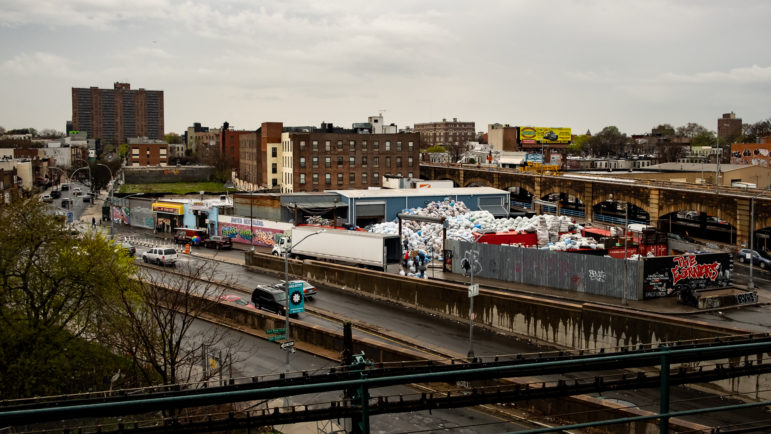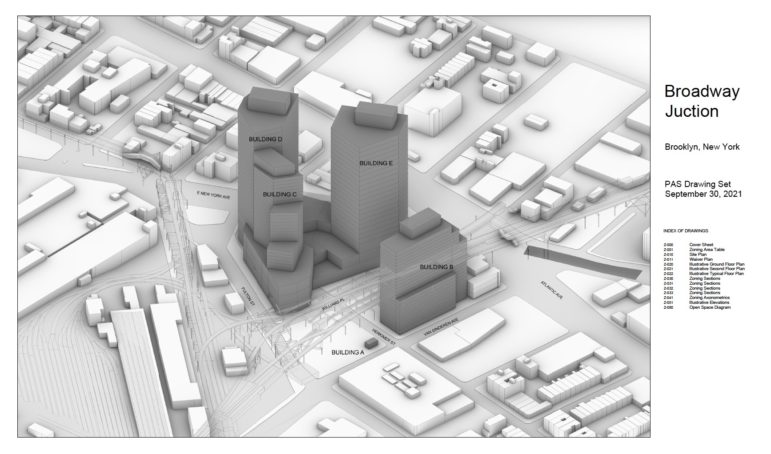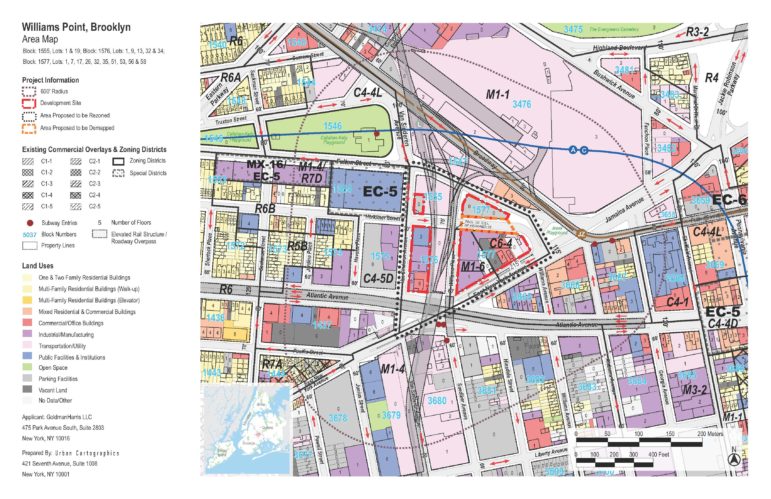The project would create about 664 housing units, two commercial towers and a new park in place of vehicle lots and low-rise buildings in an area that city officials have been eyeing for years for potential economic and real estate development.

Adi Talwar
The intersection of Atlantic and East New York avenues, pictured here in 2019.A Brooklyn-based real estate developer has submitted a proposal to rezone a four-block area at bustling Broadway Junction and surround the transit hub’s elevated subway tracks with mixed-use towers reaching up to 455 feet.
The firm Totem Group submitted preliminary materials to the Department of City Planning (DCP) in October, a first step in the rezoning process before a formal land use application. In the filing, which DCP shared with City Limits, Totem said the project would create about 664 housing units, two commercial towers and a new park in place of vehicle lots and low-rise buildings home to small manufacturing firms. Several lots currently sit vacant.
Their plan would significantly increase manufacturing, commercial and residential densities across the four-block span—an area that city officials have been eyeing for years for potential economic and real estate development.
“The proposed rezoning and other actions would assist Broadway Junction, one of the largest transit centers in NYC, to fulfill its potential as ‘a more accessible and dynamic transit hub and economic center,’” Totem Group wrote in the proposal, citing a phrase used in a 2019 report by the New York City Economic Development Corporation (NYCEDC) and DCP.
Broadway Junction features stops along the A, C, L, J and Z subway lines and neighbors the Atlantic Avenue Long Island Rail Road station. Developers and city officials have long sought to redevelop the area, with plans picking up steam in the wake of a controversial 2016 rezoning of nearby East New York. But that rezoning, the first neighborhood-level land use overhaul under Mayor Bill de Blasio, has been criticized for fueling gentrification and displacement without creating a sufficient number of homes affordable to low-income local residents.
In the submission, Totem said they would “explore” financing to make 100 percent of the new units affordable to New Yorkers earning a percentage of area median income (AMI)—a formula used to determine appropriate housing costs (roughly 30 percent of household income) for low- and middle-income renters. The “affordable” designation is relative: An apartment priced for a three-family household earning $85,920 (80 percent of AMI) would remain well out of reach for the average East New York resident, where the median household income is $44,234.
The proposed rezoning area is split into three parcels, with most of the lots owned or leased by Totem and its subsidiaries. On one parcel, an 18-story senior housing facility with 416 units would rise next to an existing church and hotel at Herkimer Street and Van Sinderen Avenue.
On a second site, the developers propose removing a block-long stretch of Herkimer Street, uniting two triangular lots and paving the way for a large mixed-use complex between Fulton Street, East New York Avenue and Williams Place. That development would feature three towers up to 24 stories tall—with a maximum height of 455 feet—each attached to a three-story commercial complex. One tower would have 248 residential units and the other two would include a combined 850,000 square feet of office space. The third parcel would feature a park.

NYC DCP
A rendering of Totem Group’s plans for the four-block area.The plan details and site renderings are located in a pre-application statement, a package of materials that developers submit to DCP before filing a formal Universal Land Use Review Procedure (ULURP) application. The filing allows city officials to review the broad strokes of a rezoning proposal.
A spokesperson for Totem said the firm is still at least a year away from submitting an actual ULURP application for what it calls the “Herkimer-Williams” project.
“In the meantime, we look forward to engaging with the community, including residents, leaders, and local partners to ensure this project, which aims to deliver 100 percent affordable housing and much needed jobs at a critical transit hub, is best suited to elevate and support East New York,” the spokesperson said.
Whatever the timeline, the proposal may have a key supporter in City Hall.
Totem’s principal, Tucker Reed, recently served on Mayor Eric Adams’ economic development transition team, and as Brooklyn borough president, Adams has long backed plans to redevelop the area around Broadway Junction. In 2017, he and then-Councilmember Rafael Espinal formed a task force of local stakeholders to develop goals for “reimagining” the neighborhood. The Broadway Junction Working Group released its ideas in a 2019 report, which called for protections against displacement for local businesses and nearby residents, employment opportunities and accessibility for people with disabilities throughout the transit hub.
At the time, Adams said he used to frequent Broadway Junction as a transit cop and envision a more dynamic environment. “It planted a seed of ‘What if?’” he told the New York Times in 2017. “There are great possibilities here.”
In November, DCP and NYCEDC said Espinal’s early exit from the Council, combined with the COVID pandemic, slowed momentum on those redevelopment plans.

NYC DCP
A zoning map of the project area.East New York’s new city councilmember, Sandy Nurse, said she plans to host additional community forums about overhauling the area to ensure new homes are deeply affordable for people earning 20, 30 and 40 percent of AMI.
“The redevelopment of Broadway Junction would have major impacts on the neighborhoods of Bushwick, Brownsville, Cypress Hills and East New York. As such any redevelopment must specifically center the needs of these communities,” she said Tuesday. “More than anything we will need to have a strong say in what this development project will look like.”
The proposed rezoning area is located next to a New York City Human Resources Administration office facility already in development. Much of the existing space, including two lots leased to the MTA, is used for parking and old vehicle dumping. Rezoning supporters say the project would improve an area that more than 100,000 New Yorkers pass through each day while fueling the creation of nearly 4,000 new jobs promised by the city following the 2016 rezoning.
“What Broadway Junction provides is parking around a transportation hub in Brooklyn,” said Bill Wilkins, director of the Local Development Corporation of East New York. “How does that make sense? It doesn’t.”
He said the proposed project reflects “community-driven development” that would create affordable housing and jobs for residents of East New York and surrounding neighborhoods, like Bushwick, Brownsville and Bedford-Stuyvesant.
“East New York is rich with assets and possibilities and it can be improved, so let’s do it intelligently,” he added. “Because at the end of the day, if you have millions of riders, why not provide shopping opportunities, housing opportunities, cultural opportunities and open space.”
But other local leaders and activists say they would oppose a project that replaces manufacturing space and remain skeptical of another local rezoning following the 190-block East New York plan.
READ MORE: House Flippers Continue to Target East New York. Residents Blame the 2016 Rezoning
The Coalition for Community Advancement, a network of advocates, residents, business owners and community board members, reviewed the Totem proposal and said they “stand against any area-wide rezoning.”
“In any redevelopment of Broadway Junction, we call for a community benefits agreement attached to each development as well as the creation of local jobs and opportunities for local businesses to grow,” the coalition said in a statement, before warning that the area could mimic the redevelopment of Downtown Brooklyn into a high-priced, glass-tower enclave.
“We do not want Broadway Junction to become another failed Metrotech,” they said.










2 thoughts on “Brooklyn Developer’s Rezoning Proposal Would Add 400-Foot Towers to Broadway Junction”
Having worked extensively in that exact area, although I am usually against such development, this proposal would actually be a benefit to whatever residents are nearby. 95% of this area is parking lots and completely vacant manufacturing buildings that have not been used since the 1960s. The area is also starved of any retail or dining options. It is a very industrial area, that isn’t being used by industry any longer. This proposal will bring some amenities to an otherwise barren neighborhood. Glenn in Brooklyn, NY.
I’m super excited about this development. This area has so much potential. Manhattan and Downtown Brooklyn can stop being the only places that get attention. Stop neglecting this high potential area. We need Starbucks, whole foods, trader joes, etc.